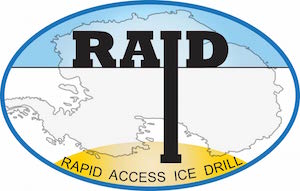Design of RAID began in March, 2013 and resulted in a completed design by December that year. Construction of the RAID system began in August, 2014. Our first integrated field tests of the drill and fluid recirculation system were completed in early 2015 in the mountains near Bear Lake, Utah. Since then, additional fabrication and testing continued through 2015, capped by integration and validation testing in Salt Lake City from August to November, 2015. In preparation for Antarctic field trials, the drilling system was transported to California for vessel loading and shipment to Antarctica in the 2015-16 austral summer. After off-loading in early 2016 and winterization, the rig was readied for field trials in the 2016-17 austral field season.
The first Antarctic field trials (AFT1) were completed in 2016-17 on a small piedmont glacier at Minna Bluff, resulting in completion of some key operational goals. Additional field trials (AFT2) were conducted in 2017-18 with successful penetration of firn and placement of a packer seal. Further technical development was done in 2018-19 and a third round of field trials (AFT3) were completed in 2019-20.
During AFT3, we successfully completed a ‘top-to-bottom’ operational sequence in three boreholes by (1) augering through firn, (2) creating a borehole packer seal in non-porous ice, (3) establishing fluid circulation, (4) quickly drilling a borehole in ice at penetration rates up to 1.2 m/min, (5) acquiring a short ice core at depth, (6) penetrating the glacial bed at a depth of ∼677 m, (7) recovering a 3.2 m core of ice, basal till and subglacial bedrock, (8) optically logging the borehole on wireline, (9) testing hydrofracture potential by overpressuring the borehole fluid and (10) operating in an environmentally benign yet rapid field mode. Minna Bluff testing, therefore, demonstrated the effectiveness of the integrated RAID system to drill rapidly through thick ice and penetrate across the glacial bed to take cores of bedrock.
